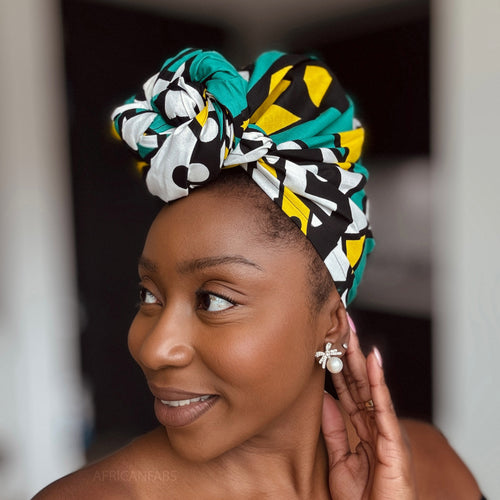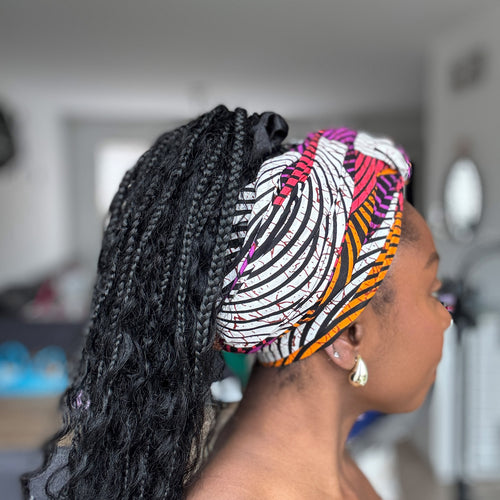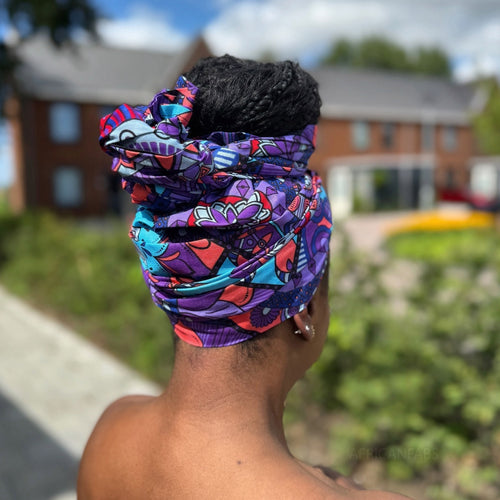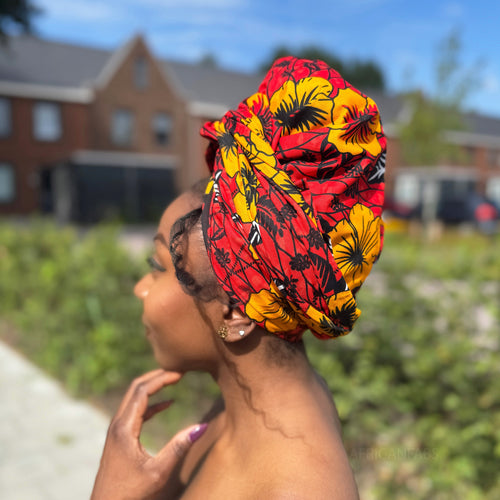African Headwraps
African headwraps. These ankara headwraps are made wax fabric, 100% cotton. An African headwrap is also called a headtie, head scarf, headband or turban. These headwraps are printed double-sided with vibrant and stunning colors.
Looking for different ways to tie your headwrap?
Customers often ask us if we have a manual on how to tie an African headwrap. Because there are many possible headscarf styles, and it is hard to explain by just text, we decided to make an instruction video. If tying an African headwrap is still too difficult for you.. no worries! Check out our Easy headwraps! These are partially pre-wrapped headwraps, containing a high quality satin liner to protect your hair! It's a combination between a satin bonnet and a turban.
To tie a headwrap, you must first prep your hair underneath, as this forms the foundation of the style. You can leave your hair down or put it up depending on the shape you would like to achieve with the scarf. With so much room for customisation, you mostly cannot go wrong with headwraps. Here is an easy step-by-step guide on some basic styles.
Headwraps: More than a fabric
Headwraps are a timeless fashion trend across the globe. It has its origin from different cultures in different parts of the world. From Africa to the Middle East to Asia, they come in different colours, shapes, patterns, and sizes. They are worn in different styles for various reasons.
For this blog, we will focus solely on African Headwraps.
The African Headwrap
A piece of fabric tied around the head in an intricate or simple style which can be worn on special occasions or a casual day at home. Although it seems like just a piece of clothing, African headwraps are much more than just that; they are incredibly versatile and tell several stories.
The beautiful names of African Headwraps
The African headwrap, also known colloquially in most African countries as head-tie, originates from all over sub-Saharan Africa and Egypt and has several names given by the different tribes within Africa.
The Igbos/Ibos from Nigeria call it “Akwa-isi” or “Ichafu”, Yorubas call it “Gele”; a tribe in South African call it “Doek”. In Ghana and Malawi, it is called “Duku” and “Dhuku” in Zimbabwe, while the Egyptian royal (Pharoah’s) headwrap is called “Nemes”.
The Modern-day African Headwrap
African Headwrap has grown beyond the African and Global Black Community, finding its way into editorial magazines and runways as a unique expression of Black identity and culture and an appreciation of black culture by other non-black cultures. African headwraps are worn today for practically any occasion and by so many different people regardless of their heritage. We call it cultural appreciation, and we’re here for it.
The African Headwrap is the gift that keeps on giving
No matter your outfit, the African headwrap is an easy way to add a touch of colour and sophistication to your style. The versatility of the African headwrap leaves it with so many functions. Here are some of the reasons to wear one:
- Self-expression: Tying the headwrap to your desired style is a form of self-expression. You can make it as intricate or as simple as your style demands.
- Hair protection: Silk or satin headwraps are an alternative to night-time bonnets to protect our tresses from the cotton beddings which tend to dry out our hair at night.
- Alternative to hairstyling: Headwraps can stand on their own as a protective hairstyling. Wear it when you don’t feel like manipulating your hair or just to wear your hair differently from your usual style.
- Ceremonies: Weddings and cultural ceremonies are perfect scenarios to show off your intricately tied headwraps.
- Alternative to a Fascinator: African headwraps can perfectly accessorise your evening wear or church outfit as long as you carefully pick your fabric and colours.
- Celebrate African heritage: This is an apparent reason and absolutely worth noting. Regardless of your heritage, you can celebrate African heritage by donning an African headwrap.
Headwraps at African Fabs
At African fabs, we endeavour to share this unique piece of African clothing with the world. Regardless of your culture, you can wear our headwraps, and we make them easy to style. Our headwraps are 2 yards of 100% cotton fabric in African print. They are sturdy and rectangular shaped, with seamed edges which become more flexible and easier to tie after the first wash.
We offer two kinds of headwraps, the standard 100% cotton headwrap and another one we call “Easy headwraps”. Easy headwraps are pre-wrapped headwraps lined by high-quality satin, making them somewhat of a satin bonnet and a headwrap combination.
The roots and meanings of African Headwraps
The African headwrap is one of the most popular statement hair accessories. Going back to its roots, it is so much more than just a fabric to cover the head. It has always been a symbolic expression of identity and style and had a practical function of protecting the hair and scalp from the harsh sun and sweat.
Dating as far back as pre-colonial times, this unassuming “piece of fabric” tells a story of wealth, marital status, religion, mourning or reverence, ethnicity and even family lineage. The differences in these stories are the styles, colours, types of fabric or where and when the headwrap is worn.
The Transatlantic History of Headwraps
With so many years of history behind it, an African headwrap is far more than just a fashion trend. It is a symbol of tradition and a people who remain unbroken today. The transatlantic slave trade added a different meaning to headwraps, one that cast a bleakness in the future of the people taken from their land in Africa into slavery in America and Europe.
During the slavery era, enslavers were responsible for the enslaved people’s dress code.
In 1735, the Negro Act was passed, stipulating what black people were allowed to wear. At about the same time in Louisiana’s Spanish colony, the Edict of Good Government was passed and stated that all black women must wear their natural hair bound in a “kerchief “ or “tignon”. These were enforced as there was a concern that European men found black and biracial women more attractive. Therefore, this piece of clothing was a tool used to discourage enslavers from pursuing “less worthy” women. In addition, white women insisted on this dress code to set a clear distinction between the mistress of the house and an enslaved person. As a result, headwraps became a symbol of slavery and inferiority in Europe and the Americas. Despite this new meaning, the black women subjected to slavery refused to accept this new definition of the dress code of their ancestors. Instead, they found their unique ways to express themselves using headwraps. The headwrap was an object of oppression from one vantage point. Still, from the other, the perspective of the slave community, it was a tool of empowerment, and the unique methods of styling the headwraps provided a sense of individuality and a degree of freedom of expression.
Later in the 1960s and 1970s, African-Americans began to embrace their heritage as a means of rebellion and pride. By the 1990s and 2000s, artists such as Lauryn Hill, Erykah Badu and India Arie popularised the African headwraps, slowly unveiling the bleakness cast over it during the slave trade era.
An African headwrap is a reminder of that which is already within - strength, royalty, and the legacy of an unbreakable people. It brings with it a commonality among Black people across the globe.
While we spread cultural appreciation through our headwraps, anyone who chooses to wear an African headwrap should find value in understanding that African headwraps have found a notable place in the history of Diaspora culture and style.
Author: Dina of HeyTresses is a medical doctor, a skin and hair follicle scientist and the founder of HeyTresses - a natural hair blog and hair product line.




























































